
Jan 13 – Feb 12, 2006
Ushuaia – San Sebastian (Argentina) – Porvenir – Punta Arenas – Puerto Natales (Chile) – El Calafate (Argentina)
¡Acá estamos! Patagonia was one of the last spaces on earth settled by Europeans. And it is not without reason. This windswept, barren region of southern Argentina and Chile didn’t lend itself to optimal colonisation due to its remoteness and dangerous sea access. Where the Andes don’t provide a natural border
between the two countries, an arbitrary line in the landscape does the trick. Either way, the bog water is as murky and the wind as fierce on both sides.

We landed in Ushuaia on a very trouble free flight from Buenos Aires. Thumbs up for Aerolineas Argentinas, who got us there cheaper than the buses and without any hassle of packing bikes or paying excess luggage.
Ushuaia, situated on the isle Tierra del Fuego, is the southern most city in the world, earning the title Fin del Mundo. It’s down near there that the Ruta 3 commences its 3,000km track to Buenos Aires and a good place for us to start our northerly journey.

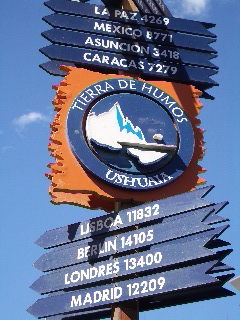
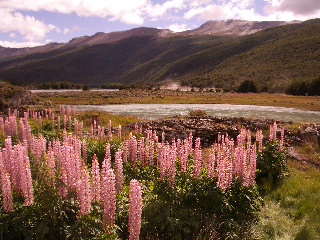
Mid January provided us with some exceptionally pleasant weather to enjoy this welcome change of scenery and climate.Snow-capped mountains form the backdrop for this tranquil port, while pink and purple lupins contrast with the colourful corrugated iron and wooden houses. Fairytale woods of lenga and ñire abound with hairy lichens and mosses giving them an eerie feel.
Four days cycling brought us to the border with Chile at San Sebastian. Having crossed the tail of the Andes outside Ushuaia, the landscape gave way to flat bog land and diminishing quantities of trees… and shelter. Having a picnic out there means crutching under a bridge, if you can find one. You had better hold onto the salami on your bread, otherwise the wind will sweep it from under your eyes.

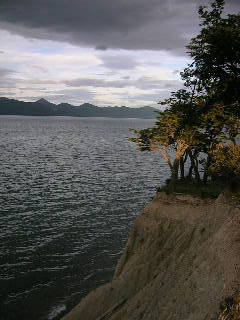
The rain can be very persistent too. At the end of our wettest day so far, Darina found a half litre of water and a goldfish or two in her boots 😉 However, some wonderful wild camping spots with lakeside view did compensate.
Read more Argentina below.

Having crossed the border into Chile, still on Tierra del Fuego, that’s when the wind started with a vengeance. On a dirt, gravel road, it was a hard old slog west to Porvenir, some 150 km away. On day two, after about 5 hours pushing into gale force winds, a pick up truck stopped.
Gerardo, a friendly Chileno, emerged for a chat, which resulted in a free ride into town via the gold-mining valleys of yesteryear. Gerardo and his wife María Angelica were on holidays with Marcela, the pilot of the truck. It was a very enjoyable and informative spin spotting upland geese and guanacos of the llama family.

From the quaint Porvenir it was a two-hour ferry ride across the Strait of Magellan to Punta Arenas in mainland Chile. The local penguin colony at Seno Otway was well worth the visit. Watching these cute, flightless, busy birds waddle to and fro, and yawn and scratch between the odd shameless squirt, is entertainment not to be missed.


Penguins at Seno Otway
And so started our ascent of mainland America. This was, alas, not without a whole lot of hardship. On a route like this you begin to put things into perspective. Rain is no longer a problem when you have a storm blowing you off the road to the point you’re not sure whether to laugh or cry! This is character-building stuff, designed for hard-core cyclists. We haven’t decided if we merit that title yet, but we did discover that the use of choice language provided us with enough adrenalin to make it through the next blast attack!
One of these fine days, at wits end mid-afternoon, four friendly lads flagged us down and invited us behind the only bush for miles around to a full-on asado (BBQ).
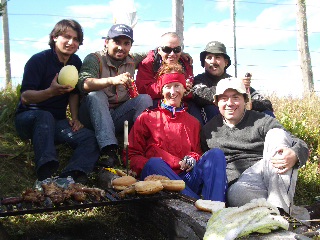
These four bankers out on a male bonding fishing expedition managed to cook up a storm (excuse the pun!) of prime Magellanes lamb, chicken and sausages. A very enjoyable afternoon and evening was spent eating and drinking, talking and laughing so that was the end of cycling for the day.The tent was pitched and the left-overs gladly devoured for supper!
Waking up to a frozen tent is just part of the deal and a 5.30am start at first light was intended (in vain) to beat the worst of the wind. Daylight until 10.30 pm means we have loads of time to get to our destination before nightfall.
Then it was time for expedition shopping in Puerto Natales, the gateway to Chile’s Torres del Paine National Park. Weighed down with food for 10 days, we headed out of town.
Our approach route to the park was the closed back entrance which offered wonderful views of the Torres mountain range and its amazingly blue lakes for hours on end. Hours- because the road would be more suited to a cog-wheel train than two over-loaded touring bikes. We got there with a lot of pushing, pulling and animated, colourful adjectives.
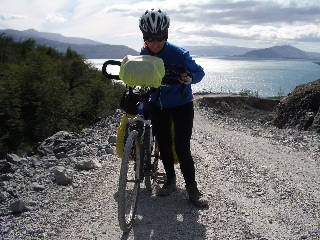
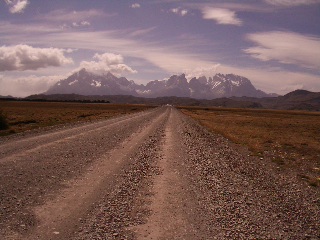
On reaching the park, renowned for its winds of up to 150kmph, it was a case of hang onto the bike for dear life. Kurt was blown off the road twice and Darina, twice a minute!
The Torres del Paine park itself is a hikers’ paradise and looks a whole lot more impressive than on any calendar picture. From the sheer lava-topped granite cliffs to the ice-bergs floating on Lago Grey, backed by lunar landscape as well as lush green valleys, home to guanacos and condors, this park offers a feast for the eye for hikers and bikers alike. Exiting the park offered wonderful views but on a corrugated gravel road it was a very bumpy, shaky, dusty 70km to the Argentine border. Theme of the week: We’re all shook up!
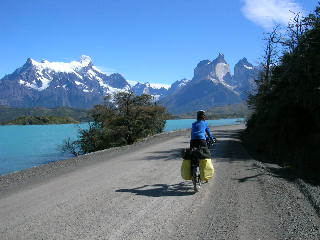

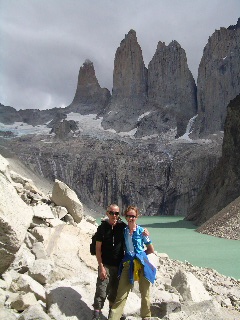

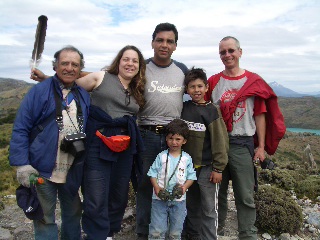
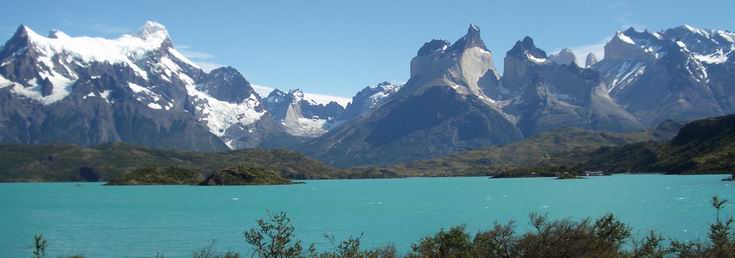
Read more Chile below

It may be rough country out there, but we’re not the only locos on bikes. We’ve met Japanese, German, Dutch, American, British, Italian, Spanish French, Peruvian and Brazilian cyclists all pushing against the gales in various directions. It’s reassuring to meet others at the same game, and exchange valuable information on camping and water possibilities.
Wildlife also provides diversion en route. Pink flamingoes in blue lagoons, ñandús, alpacas and guanacos grazing on the hills, upland geese and condors flying overhead are some of the many delightful sides of cycling in this wild land.
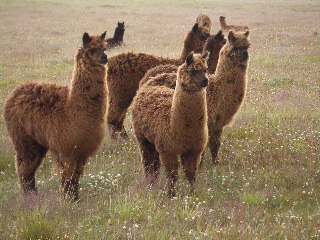
In Brazil we thought we knew what distance meant when we had to cycle 50 km between restaurants or shops. In Patagonia, however, we go for 4 days without any sign of civilization. Cop shops are about the height of it and a great place to refill with water.

We generally carry food for 5 days and camp where we can on the side of the road. Shelter, as we mentioned, is of utmost importance and when there isn’t a tree or bush in sight, it’s safer just to roll out the sleeping bags, hope for a dry night and save the tent intact for another day. It’s hard to beat a 1000-star hotel!
After a long, slow 80km cycle and happy to be finally on a paved road into El Calafate, the heavens opened and there was little in the line of a protected 5m square spot for our tent. A spin from Omar, Carol and family, on holidays from Buenos Aires was just the business!

El Calafate is a town that lives off tourism because of it’s proximity to the beautiful Perito Moreno glacier.

This massive ice mass of 14km by 5km is a wonder. Because it pushes ahead 2m per day, there’s a lot of groaning and cracking to be heard, in addition to the spectacular sight of 50m high blocks of ice calving into the milky lake it feeds. Just like the granite peaks of Torres del Paine, the glacier pinnacles look a whole lot better in reality that they did on the back of our bathroom door in St. Gallen!

Like everyone else travelling in this part of the world, we’re making our way, by hook or by crook…
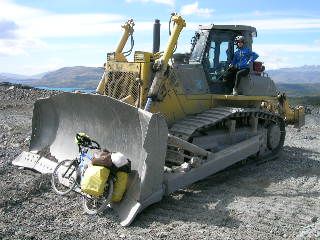

Doing it our way

…but, as you can see, not everyone makes it!
